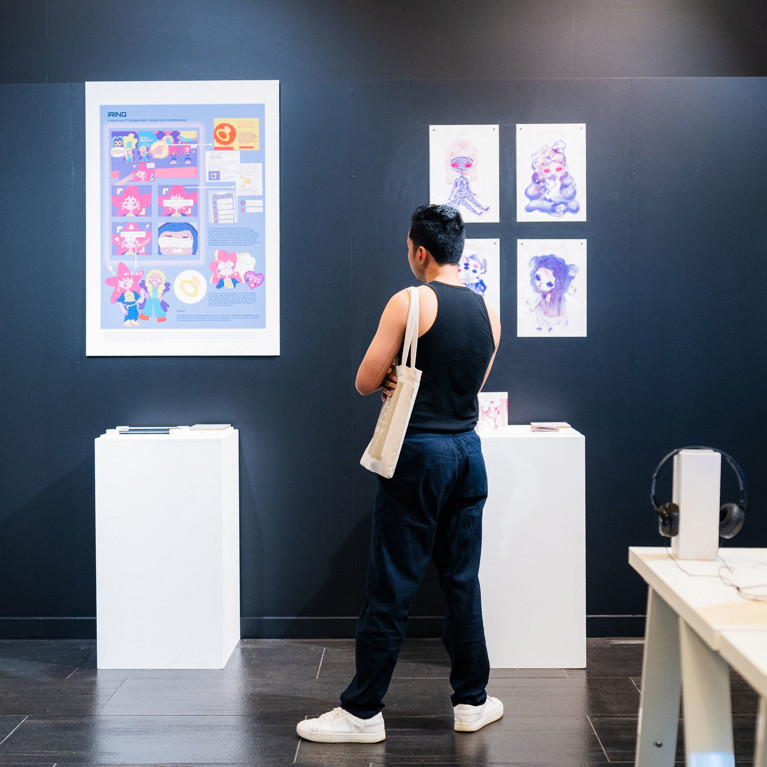Storytelling — about brands, data, people, experiences, opportunities — is important to every industry and field of knowledge. Visual communication is a key to bringing many of these stories to life.
This broad-based design discipline uses visual techniques to communicate information and ideas in meaningful and inspiring ways. From animations and illustrations to typography, infographics, colours and layouts, visual communication is all about building connection through design.
How to become a visual communication designer
The first step towards a visual communication career is enrolling in an industry recognised qualification — and there’s no better place than UTS, Sydney’s #1 university for art and design (and #46 in the world!)*. Our Bachelor of Design in Visual Communication will equip you with theoretical knowledge, the practical, creative and technological competencies, and the industry connections to find your footing in this dynamic field.
* QS World University Rankings by subject 2024
Where can a visual communication degree take you?
Previously, a visual communication degree would teach you how to become a graphic designer — and if that’s your area of interest, then this degree is still a great fit. But with the ongoing emergence of new technologies, and with a growing appreciation for the role of designers in building human connection, employment opportunities in visual communication are expanding at a rapid rate.
Read on to see where the Bachelor of Design in Visual Communication can take you.
Five visual communication careers you should consider
1. Graphic designer
Graphic design is the OG of visual communication careers. As a graphic designer, you’ll work in print or digital media (or both!) to produce designs for publications, advertisements, book covers and anything else that combines visual design with informational content. Like many professions, graphic design is being reshaped by AI — now, digital technologies are taking over the rote and repetitive work, leaving designers free to apply their creativity to more complex and rewarding challenges.
Interested? Similar careers include information designer, publication designer or illustrator.
2. Motion graphics designer
If you’ve ever seen an animated ad or infographic or those wildly creative credits at the start of a movie, then you’re already familiar with motion graphics design. This discipline is about presenting information through compelling digital motion. Motion graphics sits at the intersection of design and animation, but while it’s a highly creative profession, its application isn’t limited to the creative sectors — motion graphics design expertise is increasingly sought by corporations to enhance stakeholder communication.
Interested? Similar careers include animation designer, art director or multimedia designer/editor.
3. User experience/user interface (UX/UI) designer
More than almost any other design disciplines, user experience (UX) and user interface (UI) design places people at the centre of the design process. UX design is about shaping the way that people experience products, services or environments, while UI design is concerned with the interfaces that users interact with.
Think of an app — a UX designer will research the needs of the target audience, design a logic flow for user activity, and think about how to solve problems that users might run into. By contrast, a UI designer will focus on the app’s aesthetics and functionality, including log-in screens, buttons, music, and menus.
Interested? Similar careers include web designer or interaction designer.
4. Information Designer
Information designers use visual storytelling to distil complex information into accessible and digestible formats — and in the era of big data, they’re sought after across countless industries. Using tools like typography, colour and layout, information designers produce everything from infographics to explainer videos, museum catalogues, maps and signage to help audiences navigate and make sense of the world.
Interested? Similar careers include graphic designer, data visualisation or way-finding specialist.
5. Branding specialist
In the business world, branding is everything — a company’s brand tells audiences who they are, what they offer and where their values lie. Branding specialists are hands-on with every aspect of the company’s brand, including logos, colour schemes and typography, to name a few. They undertake market research to guide brand positioning, develop new brands or refresh existing ones, and oversee the branding guidelines that shape how brand assets can be used.
Interested? Similar careers including marketing consultant and creative strategist.
Ready to take the first step towards a visual communication career? Explore the UTS Bachelor of Design in Visual Communication or contact us to find out more.


